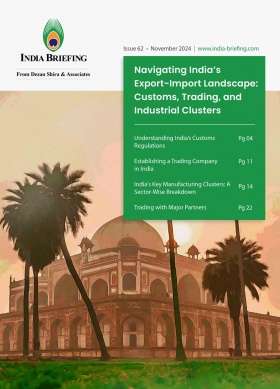Understanding India’s New HSN Code Guidebook 2025
India’s new HSN Code Guidebook (2025), released on October 6, 2025, introduces a unified framework for classifying goods under the GST 2.0. and Customs systems. Released by the Department For Promotion of Industry and Internal Trade (DPIIT), the guidebook maps over 12,000 HSN codes, aligning India’s classification structure with global WCO standards.
India has released a new HSN Code Guidebook to provide greater clarity and uniformity in product classification under the revised Goods and Services Tax (GST) and Customs framework. The comprehensive dossier, released to the public on October 6, 2025, is a key step in improving tax transparency, compliance accuracy, and ease of doing business, particularly for manufacturers, importers, and exporters who rely heavily on correct product categorization.
In a modern, complex trade environment where classification discrepancies can lead to tax disputes, delayed shipments, or compliance penalties, the new guidebook can serve as a much-needed reference for businesses navigating India’s evolving indirect tax landscape.
It also incorporates an updated classification framework aligned with recent amendments to India’s Customs Tariff and the World Customs Organization (WCO) revisions, ensuring consistency with international nomenclature standards.
The document is digitally accessible via the DPIIT website: dpiit.gov.in/
Understanding features of the new guidebook
In September 2025, the central government unveiled a comprehensive guidebook mapping 12,167 HSN (Harmonized System of Nomenclature) codes to 31 ministries and departments.
By linking each HSN code to its corresponding administrative authority, the new guidebook seeks to simplify regulatory decision-making, eliminate jurisdictional overlaps, and enable faster, data-driven policy responses.
Out of the total 12,167 HSN codes, 11,651 have been formally accepted by the respective ministries and departments.
|
HS Codes Accepted by the Central Government Ministries/Departments |
||
|
S. no. |
Ministry/department |
HS codes (8-digit level) |
|
1 |
Department Of Agriculture & Farmers Welfare |
289 |
|
2 |
Ministry Of Ayush |
49 |
|
3 |
Department Of Chemicals and Petro-Chemicals |
1,900 |
|
4 |
Department Of Fertilizers |
29 |
|
5 |
Department Of Pharmaceuticals |
618 |
|
6 |
Ministry Of Civil Aviation |
49 |
|
7 |
Ministry Of Coal |
30 |
|
8 |
Department Of Commerce |
348 |
|
9 |
Department For Promotion of Industry and Internal Trade (DPIIT) |
2,938 |
|
10 |
Department Of Telecommunications |
48 |
|
11 |
Department Of Posts |
1 |
|
12 |
Department Of Food and Public Distribution |
55 |
|
13 |
Ministry Of Culture |
25 |
|
14 |
Ministry Of Defence |
25 |
|
15 |
Ministry Of Electronics and Information Technology (MeitY) |
178 |
|
16 |
Ministry Of Environment, Forest and Climate Change |
125 |
|
17 |
Department Of Fisheries |
374 |
|
18 |
Department Of Animal Husbandry and Dairying |
264 |
|
19 |
Ministry Of Food Processing Industries |
869 |
|
20 |
Ministry Of Heavy Industries |
841 |
|
21 |
Ministry Of Information and Broadcasting |
49 |
|
22 |
Ministry Of Mines |
666 |
|
23 |
Ministry Of New and Renewable Energy |
2 |
|
24 |
Ministry Of Petroleum and Natural Gas |
86 |
|
25 |
Ministry Of Ports, Shipping and Waterways |
34 |
|
26 |
Ministry Of Power |
3 |
|
27 |
Ministry Of Railways |
34 |
|
28 |
Ministry Of Steel |
567 |
|
29 |
Ministry Of Textiles |
2,176 |
|
30 |
Department Of Sports |
34 |
|
31 |
Department Of Atomic Energy |
45 |
|
32 |
Total |
11,651 |
Source: Guidebook on Mapping HSN Codes 2025; Ministry of Commerce and Industry
The remaining 516 codes are categorized under a residual grouping, with proposed alignments to ensure complete administrative coverage across sectors.
Three-pillar framework for policy and trade enhancement
The guidebook outlines a three-pillar framework designed to help ministries and departments utilize HSN code mapping to support industrial growth, quality enhancement, and trade competitiveness.
1. Manufacture in India
It emphasizes strengthening domestic manufacturing through data-driven decision-making. HSN-level insights enable ministries to formulate targeted, product-specific policies, identify value chain links across raw materials and machinery, and align skill development initiatives with industry requirements to enhance workforce efficiency.
2. Strengthen ‘Brand India’
The second pillar focuses on improving product quality and compliance, this pillar promotes the creation of a robust quality assurance ecosystem.
3. Make for the world
The third and final pillar supports the enhancement of India’s trade performance through import monitoring, substitution, and export promotion. Data derived from HSN mapping assists ministries in tracking import patterns, identifying domestic production opportunities, and prioritizing export-oriented products with strong comparative advantages. These insights contribute to evidence-based trade policy formulation and strengthen India’s position in international trade negotiations.
Enhancing the effectiveness of trade agreement negotiations
India’s expanding network of Trade Agreements (TAs), including Free Trade Agreements (FTAs) and Comprehensive Economic Partnership Agreements (CEPAs), has become a central tool for advancing economic integration, improving market access, and strengthening global competitiveness.
The 2025 HSN Code Guidebook is expected to augment India’s trade negotiation capabilities by providing ministries and policymakers with granular, product-level intelligence. Through precise mapping of over 12,000 HSN codes, the guidebook enables a more data-driven and coordinated approach to formulating India’s trade positions.
By offering detailed classification and sectoral ownership of products, the guidebook allows negotiators to:
- Identify strategic product categories for tariff concessions or protection based on their economic importance and domestic sensitivities.
- Formulate accurate Rules of Origin (ROO) by understanding the product’s value chain, component structure, and industry linkages.
- Assess non-tariff measures (NTMs) such as technical standards, quality control orders, and regulatory requirements that may affect market access.
- Develop evidence-based negotiation strategies, ensuring that tariff liberalization aligns with India’s industrial priorities and global competitiveness goals.
This structured and analytical framework helps align trade discussions with national economic priorities, sectoral strengths, and value-chain interdependencies. As a result, India’s negotiating teams can engage in more coherent, consistent, and strategically informed trade dialogues, ensuring that new and existing trade agreements deliver balanced benefits across industries.
CLICK HERE: GST Reforms in India: How Foreign Companies Can Prepare
Understanding the structure and application of HSN Codes
In India, the use of HSN codes under the GST framework varies based on the annual turnover of a business:
- Turnover below INR 15 million (US$169,951): HSN code reporting is not mandatory.
- Turnover between INR 15 million (US$169,951) and INR 50 million (US$566,504): Businesses must use 2-digit HSN codes.
- Turnover above INR 50 million (US$566,504): Businesses are required to use 4-digit HSN codes.
- Import, export, and international trade: Require 8-digit HSN codes to align with global standards.
Classification hierarchy of HSN codes
The HSN system follows a tiered classification structure, organizing goods from broad categories to specific product types:
- Section (2-digit level): The system begins with 21 sections, each representing a broad class of goods. Example: Section I – Live Animals and Animal Products.
- Chapter (2-digit HS Code): Each section is divided into chapters that refine the categorization. Example: Chapter 1 – Live Animals.
- Heading (4-digit HS Code): Chapters are further broken down into headings for more specific groupings. Example: Heading 0102 – Live Bovine Animals.
- Subheading (6-digit HS Code): Headings are subdivided to identify particular goods in detail. Example: Subheading 0102.21 – Pure-bred Breeding Animals.
- Tariff line (8-digit HS Code): In India, tariff lines provide the most detailed classification, used for Customs and international trade. Example: Tariff Line 0102.21.10 – Bulls.
Compliance and business implications
Accurate HSN classification is not merely a documentation exercise; it directly impacts tax liability, compliance status, and operational efficiency.
- GST return accuracy: Correct HSN codes ensure that GST returns, and e-invoices match system validations, reducing errors and reconciliation issues.
- Avoidance of penalties: Misclassification can lead to tax underpayment or overpayment, both of which attract penalties or refund delays.
- Audit preparedness: Clear documentation based on official references strengthens a business’s position during GST audits or departmental inquiries.
- Trade documentation: Proper classification facilitates smoother Customs clearance and prevents delays due to disputes over tariff headings.
Businesses are therefore encouraged to revisit their current HSN mapping in ERP and accounting systems to verify compliance with the revised guidebook. This will help in identifying mismatches, updating product masters, and training staff involved in billing or filing returns.
How the new HSN code guide supports businesses under GST 2.0
The rollout of GST 2.0 on September 22, 2025, with its focus on automation, interoperability, and data-driven compliance, underscores the need for accurate and consistent product classification. India’s new HSN Code guidebook is set to play a pivotal role in this transition by helping businesses strengthen GST reporting, minimize compliance risks, and align with future regulatory standards.
By defining over 12,000 product classifications and linking them to the relevant ministries and departments, the document eliminates ambiguity in tax treatment and supports seamless data exchange between Customs, goods and services tax network (GSTN), and e-invoicing systems. This integration ensures uniformity across trade and taxation, improving reconciliation accuracy and reducing the likelihood of compliance disputes or refund delays.
The guidebook also complements GST 2.0’s risk-based assessment framework, enabling both businesses and authorities to identify trends and anomalies more effectively.
KNOW MORE: GST 2.0: How India’s New HSN and SAC Code Structure Transforms Tax Compliance for Businesses
Advisory insights: Preparing for implementation
To effectively adapt to the new guidebook, businesses should take a structured, proactive approach:
- Conduct an internal HSN audit: Review all product and service classifications currently in use, verifying accuracy against the new guidebook.
- Update master data and ERP systems: Ensure that new codes and descriptions are reflected in accounting and inventory software.
- Train finance and logistics teams: Conduct training sessions on revised classifications and compliance requirements to reduce manual errors.
- Engage with vendors and partners: Communicate any changes in product classification to suppliers and distributors to maintain alignment across the supply chain.
- Leverage digital tools: Use online HSN search portals or professional advisory services for complex classifications, particularly for multi-component or hybrid products.
By taking these steps, businesses can ensure smooth compliance and minimize exposure to classification-related disputes or audit risks.
(US$1 = INR 88.26)
About Us
India Briefing is one of five regional publications under the Asia Briefing brand. It is supported by Dezan Shira & Associates, a pan-Asia, multi-disciplinary professional services firm that assists foreign investors throughout Asia, including through offices in Delhi, Mumbai, and Bengaluru in India. Dezan Shira & Associates also maintains offices or has alliance partners assisting foreign investors in China, Hong Kong SAR, Vietnam, Indonesia, Singapore, Malaysia, Mongolia, Dubai (UAE), Japan, South Korea, Nepal, The Philippines, Sri Lanka, Thailand, Italy, Germany, Bangladesh, Australia, United States, and United Kingdom and Ireland.
For a complimentary subscription to India Briefing’s content products, please click here. For support with establishing a business in India or for assistance in analyzing and entering markets, please contact the firm at india@dezshira.com or visit our website at www.dezshira.com.
- Previous Article India and China Resume Direct Passenger Flights: Boost for Trade, Tourism, and Regional Connectivity
- Next Article Regulatory Standards When Selling to the Indian Market








